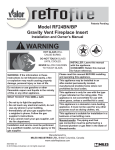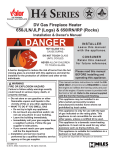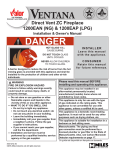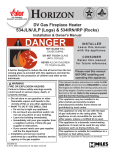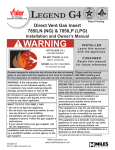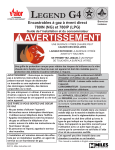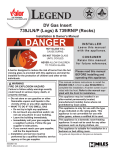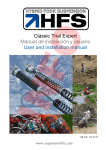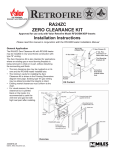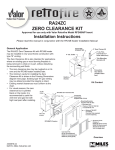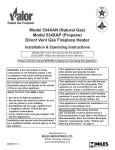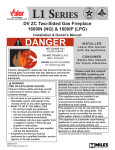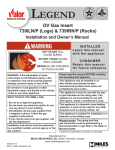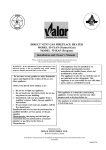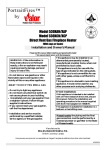Download Valor DV-190 Owner`s manual
Transcript
RETROFIRE US Patent no. 8,166,965 Direct Vent Fireplace Insert RF24IDN (NG) & RF24IDP (LPG) Installation and Owner’s Manual ! DANGER HOT GLASS WILL CAUSE BURNS. Leave this manual with the appliance. DO NOT TOUCH GLASS UNTIL COOLED. CONSUMER NEVER ALLOW CHILDREN TO TOUCH GLASS. A barrier designed to reduce the risk of burns from the hot viewing glass is provided with this appliance and shall be installed for the protection of children and other at-risk individuals. ! WARNING FIRE OR EXPLOSION HAZARD Failure to follow safety warnings exactly could result in serious injury, death, or property damage. — Do not store or use gasoline or other flammable vapors and liquids in the vicinity of this or any other appliance. — WHAT TO DO IF YOU SMELL GAS ▪ Do not try to light any appliance. ▪ Do not touch any electrical switch; do not use any phone in your building. ▪ Leave the building immediately. ▪ Immediately call your gas supplier from a neighbor’s phone. Follow the gas supplier’s instructions. ▪ If you cannot reach your gas supplier, call the fire department. — Installation and service must be performed by a qualified installer, service agency or the gas supplier. 4002315-16 © 2014 Miles Industries Ltd. All rights reserved. I N S TA L L E R Retain this manual for future reference. Please read this manual BEFORE installing and operating this appliance. This appliance may be installed in an after-market permanently located, manufactured (mobile) home where not prohibited by local codes. This appliance is only for use with the type of gas indicated on the rating plate. This appliance is not convertible for use with other gases, unless a certified kit is used. This appliance is a domestic room-heating appliance. It must not be used for any other purposes such as drying clothes, etc. This appliance is suitable for installation in a bedroom or bed sitting room. Massachusetts: The piping and final gas connection must be performed by a licensed plumber or gas fitter in the State of Massachusetts. Ce guide est disponible en français sur demande. Table of Contents FOR THE QUALIFIED INSTALLER Safety Precautions ................................................. 3 Safety and Your Fireplace ...................................... 4 Owner’s Information............................................... 5 Operating Your Fireplace for the First Time ............... 5 Cleaning Your Fireplace ............................................ 6 Checking Pilot and Burner Flames ............................ 7 Using Handset Wall Holder........................................ 7 Replacing Batteries ................................................... 8 Locating Lighting, Operation and Rating Information Plate ......................................... 8 Servicing Your Fireplace ............................................ 8 Operating Your Fireplace ........................................... 8 How to Turn Your Fireplace OFF (including pilot) ..... 8 How to Ensure Your Fireplace Cannot Be Turned ON Inadvertently ................................... 9 Remote Control Operation................................... 10 Options .................................................................. 14 Lighting Instructions ............................................ 15 Warranty ................................................................ 33 Specifications ....................................................... 16 Dimensions ........................................................... 17 Vent Configurations ............................................. 18 Vent Termination................................................... 19 Existing Fireplace Preparation ............................ 21 Installation............................................................. 22 Connect Gas Supply................................................ 22 Rough-in Vent Liners ............................................... 23 Prepare Appliance ................................................... 23 Connect Vent Liners to Appliance............................ 24 Re-install Support Legs (if removed) ....................... 24 Level Firebox in Hearth ........................................... 25 Re-install Burner Module ......................................... 25 Connect Gas Line and Test Appliance ..................... 25 Re-install Top Baffle (if removed) ............................ 25 Install Top Convection Baffle ................................... 26 Install Ceramic Log Set ........................................... 26 Refit and Check Window ......................................... 27 Synchronize Remote Control................................... 28 Check Operation...................................................... 28 Adjust Aeration (if necessary) .................................. 28 Install Barrier Screen ............................................... 29 Install Cast Iron Fret or Bottom Cover ..................... 29 Install Handset Wall Holder ..................................... 30 Wiring Diagram ..................................................... 31 Approved Venting Components .......................... 32 Warranty ................................................................ 33 Spare Parts............................................................ 34 LOR T T AN W A R RC M GR A RO P Y OR Warranty Card at the back of this manual. VA FOR THE OWNER CO M F Massachusetts: The piping and final gas connection must be performed by a licensed plumber or gas fitter in the State of Massachusetts. The information contained in this installation manual is believed to be correct at the time of printing. Miles Industries Ltd. reserves the right to change or modify any information or specifications without notice. Miles Industries Ltd. grants no warranty, implied or stated, for the installation or maintenance of your heater, and assumes no responsibility for any consequential damage(s). Designed and Manufactured by / for Miles Industries Ltd. 190–2255 Dollarton Highway, North Vancouver, BC, CANADA V7H 3B1 Tel. 604-984-3496 Fax 604-984-0246 www.valorfireplaces.com © Copyright Miles Industries Ltd., 2014 2 ! Safety Precautions READ and UNDERSTAND all instructions carefully before starting the installation. FAILURE TO FOLLOW these installation instructions may result in possible fire hazard and will void the warranty. Prior to the first firing of the fireplace, READ the Owner’s Information section of this manual. DO NOT USE this appliance if any part has been under water. Immediately, CALL a qualified service technician to inspect the unit and to replace any part of the control system and any gas control that has been under water. THIS UNIT IS NOT FOR USE WITH SOLID FUEL. Installation and repair should be PERFORMED by a qualified service person. The appliance and venting system should be INSPECTED before initial use and at least annually by a professional service person. More frequent cleaning may be required due to excessive lint from carpeting, bedding, etc. It is IMPERATIVE that the unit’s control compartment, burner, and circulating air passageways BE KEPT CLEAN to provide for adequate combustion and ventilation air. Always KEEP the appliance clear and free from combustible materials, gasoline, and other flammable vapors and liquids. NEVER OBSTRUCT the flow of combustion and ventilation air. Keep the front of the appliance CLEAR of all obstacles and materials for servicing and proper operation. This unit MUST be used with a vent system as described in this installation manual. NO OTHER vent system or components MAY BE USED. This gas fireplace and vent assembly MUST be vented directly to the outside and MUST NEVER be attached to a chimney serving a separate solid fuel burning appliance. Each gas appliance MUST USE a separate vent system. Common vent systems are PROHIBITED. INSPECT the external vent cap on a regular basis to make sure that no debris, plants, trees, shrubs are interfering with the air flow. TURN OFF the gas before servicing this appliance. It is recommended that a qualified service technician perform an appliance check-up at the beginning of each heating season. DO NOT use this heater as a temporary source of heat during construction. State of California. Proposition 65 Warning. Fuels used in gas, wood-burning or oil fired appliances, and the products of combustion of such fuels, contain chemicals known to the State of California to cause cancer, birth defects and other reproductive harm. California Health & Safety Code Sec. 25249.6. Due to the high temperature, the appliance should be LOCATED out of traffic areas and away from furniture and draperies. Clothing or flammable material SHOULD NOT BE PLACED on or near the appliance. This appliance is a DOMESTIC ROOM-HEATING APPLIANCE. It must not be used for any other purposes such as drying clothes, etc. DO NOT place furniture or any other combustible household objects within 36” of the fireplace front. BE CAREFUL not to put any decorating objects sensitive to heat to close above or around the fireplace as it gets very hot when operating. The glass door assembly MUST be in place and sealed before the unit can be placed into safe operation. DO NOT OPERATE this appliance with the glass door removed, cracked, or broken. Replacement of the glass door should be performed by a licensed or qualified service person. DO NOT strike or slam the glass door. The glass door assembly SHALL ONLY be replaced as a complete unit, as supplied by the fireplace manufacturer. NO SUBSTITUTE material may be used. DO NOT USE abrasive cleaners on the glass door assembly. DO NOT ATTEMPT to clean the glass door when it is hot. A BARRIER DESIGNED TO REDUCE THE RISK OF BURNS from the hot viewing glass is provided with this appliance and SHALL BE INSTALLED for the PROTECTION OF CHILDREN and other AT-RISK INDIVIDUALS. If the barrier becomes damaged, the barrier SHALL BE REPLACED with the MANUFACTURER’S BARRIER for this appliance. Any safety screen, guard or barrier removed for servicing the appliance, MUST BE REPLACED prior to operating the appliance. Children and adults should be ALERTED to the hazards of high surface temperature and should STAY AWAY to avoid burns or clothing ignition. YOUNG CHILDREN should be CAREFULLY SUPERVISED when they are in the same room as the appliance. Toddlers, young children and others may be susceptible to ACCIDENTAL CONTACT BURNS. A physical barrier is recommended if there are at-risk individuals in the house. To restrict access to a fireplace or stove, INSTALL AN ADJUSTABLE SAFETY GATE to keep toddlers, young children and other at-risk individuals out of the room and away from hot surfaces. 3 Safety and Your Fireplace Safety and Your Fireplace Please Read and Carefully Follow all Safety Warnings and Operating Instructions Contained in Your Owner’s Manual (Replacement Manuals are available by contacting our service department at 1-800-468-2567 or visit www.valorfireplaces.com). Please Follow These Important Child Safety Precautions and Recommendations, 4 • Parts of your Valor Fireplace become extremely hot while in operation. • The glass viewing window temperature can exceed 500 F at full capacity. Momentary contact with a hot glass surface can cause a severe burn, even if the fireplace is operating at reduced heating capacity. • The glass window will remain hot for an extended period of time after the fireplace has been turned off. Ensure that children are prevented from touching the fireplace during the cool down period. • Toddlers and Young Children must be closely supervised at all times when they are in the same room as the operating fireplace. They lack full awareness of danger and rely on your protection. Toddlers, in particular, do not have the motor skills and response reflexes to withdraw in the event of accidental contact with a hot surface. • A physical barrier is strongly recommended if there are young children, or at-risk individuals in the house. Install an approved aftermarket safety gate to keep toddlers, young children and other at-risk individuals a safe distance from the fireplace. • Keep the remote control handset out of reach of children at all times. A wall mount storage holster is provided with your remote control handset. • Ensure that the fireplace, including the pilot light, is completely turned off when children are present and close supervision and safety barriers are not available—see pages 8–9 of Owner’s Information section. • If the fireplace is not going to be used for the summer or any extended period of time, remove the batteries from the remote control handset and receiver. It is recommended that batteries are replaced annually in any event—see page 8. Owner’s Information ! WARNING EXTREMELY HOT!!! • READ the SAFETY information on pages 3 and 4 of this manual BEFORE operating your gas heater. • Some parts of your fireplace are EXTREMELY HOT, particularly the GLASS window. • DO NOT LET CHILDREN touch the glass or any parts of your fireplace even after it is turned off as it is still hot. • USE THE BARRIER SCREEN provided with the appliance, front or trim or a GATE to reduce the risk of burns. • Keep the remote control handset OUT OF REACH of children. • HOT HEARTH/FLOOR SURFACE! The hearth or floor directly in front of the fireplace is VERY HOT when the fireplace heats. Even if constructed of non-combustible materials, and although safe, it may reach temperatures in excess of 200º F depending on choice of materials. DO NOT STEP ON IT! • Some materials or items, although safe, may discolor, shrink, warp, crack, peel, and so on because of the heat produced by the fireplace. AVOID PLACING candles, paintings, photos, and other items SENSITIVE TO HEAT within 36 inches (0.9 m) around the fireplace. • Solid wood flooring in front of the fireplace (if allowed) may shrink during the heating season due to heat. Performance of LPG appliances may be affected by the quality of commercial gas supplied in your area. Fireplace Hearth Do not put furniture or other objects in this space in front of the fireplace: 36” (0.9 m) OWNER’S INFORMATION Thank You ... For purchasing a Valor by Miles Industries. Your new radiant gas heater is a technical appliance that must be installed by a qualified dealer. Each Valor fireplace is fully tested during the production process for your safety and comfort. Your unit has been professionally installed by: Dealer Name: ________________________________ Phone Number :_______________________________ Should you encounter an operational problem, call your dealer immediately. Do not try to repair the unit as you may cause an injury or damage the fireplace. This manual and particularly the preceeding and following pages contain very important information regarding the safe operation of your fireplace as well as maintenance instructions. Read carefully BEFORE operating your fireplace and pay special attention to the SAFETY WARNINGS. A heating gas appliance does require safe handling and for this reason, we very strongly recommend that no children be allowed to touch the fireplace and its controls at all times. Do install a screen or barrier in front of the fireplace to protect your children against severe burns. Operating Your Fireplace for the First Time When operating your new fireplace for the first time, some vapors may be released due to the burning of curing compounds used in the manufacture of the appliance. They may cause a slight odor and could cause the flames to be the full height of the firebox, or even slightly higher, for the first few hours of operation. It is also possible that these vapors could set off any smoke detection alarms in the immediate vicinity. These vapors are quite normal on new appliances. We recommend opening a window to vent the room. After a few hours use, the vapors will have disappeared and the flames will be at their normal height. Flame Supervision Device For your safety, this appliance is fitted with a flame supervision device which will shut-off the gas supply if, for any reason, the pilot flame goes out. This device incorporates a fixed probe, which senses the heat from the pilot flame. If the probe is cool, the device will prevent any gas flow unless manually lighting the pilot. See full lighting instructions on page 15 of this manual. 5 OWNER’S INFORMATION Owner’s Information Cleaning Your Fireplace ! WARNING DO NOT TOUCH THE GLASS WHILE IT IS HOT! Let the fireplace cool first before cleaning it. Important - Glass cleaning - Mineral deposits One of the by-products of the combustion process in a gas appliance is a mineral which can show up as a white film on the ceramic glass of the viewing door. The composition of the deposit varies widely from various locations and also from time to time in the same location. It seems this is associated with the varying sulfur content of the gas. You may have the problem for a time and then not see it for many months when it will reappear in your area. We have discussed this problem with ceramic glass manufacturers and they cannot give us a definitive answer to this problem. Dealers have tried various cleaning products with varying results. The following recommendations will not guarantee results in your particular case. NOTE: This is a problem beyond Miles Industries’ control and is not covered under warranty. • Clean the glass regularly as soon as you notice the buildup (white film). If the film is left for a longer period of time, it will bake on. It is then much harder, if not impossible, to remove. • NEVER use an abrasive cleaner on the ceramic glass. Any abrasion of the surface has the immediate effect of compromising the strength of the glass. An emulsion type cleaner is recommended. • Use a soft damp cloth to apply the cleaner. Dry the glass with a soft, dry, preferably cotton cloth. Most paper towels and synthetic materials are abrasive to ceramic glass and should be avoided. • Our dealers have had good results from the products listed below. We cannot, however, guarantee the results of these products. • BRASSO, POLISH PLUS by KELKEM, COOK TOP CLEAN CREME by ELCO, WHITE OFF by RUTLAND, TURTLE WAX Do not clean the glass while it is hot! Always securely replace the window and the barrier screen before lighting. If broken, the glass pane may only be replaced as a complete window unit as supplied by the manufacturer. If the barrier becomes damaged, the barrier shall be replaced with the manufacturer’s barrier for this appliance. It is necessary to unhook the cast iron fret and brackets or the bottom cover, as well as the barrier screen before removing the window for cleaning. ! WARNING WARNING DO NOT TOUCH THE BARRIER SCREEN OR FIREPLACE WHILE THEY ARE HOT! Let the fireplace cool first before cleaning it. 1. Remove the barrier screen. a. Open the top brackets outwards to unhook the screen top. 2. 3. 4. 5. 6. 6 b. Unhook the bottom of the screen from the window frame. Clean the barrier screen with a soft brush. Remove the window for cleaning. a. Rotate the two fastening studs at the bottom corners 90 degrees to release them. b. Swing the bottom of the window outwards to unhook the top edge. Clean the window glass following the guidelines indicated in this section. Dust the ceramic fuel effects and firebox walls using a soft brush. Dust the burner using a soft brush after removing the ceramic fuel effects. When cleaning, make sure that no particles are brushed into the slots in the burner. OWNER’S INFORMATION Owner’s Information 7. Reinstall the window. a. Hook the window over the top edge of the firebox, and fasten the bottom two spring- loaded bolts by pushing in and turning them 90 degrees. a. Hook the bottom of the screen to the bottom edge of the window frame and then push the screen against the window frame. Convection baffle Check that Window Moves Freely After Reinstallation Top view—Hook bottom of screen to bottom of window frame Spring Loaded Fastening Studs (2) 1/4 Turn b. Push the top of the screen against the top of the window frame and while holding it bend the top brackets around the window frame to secure the screen. Check that the screen is solidly hooked to the window frame. IMPORTANT: To ensure a safe operation, verify that the bolts are hooked properly to the window tabs; then, pull out the bottom of the window and release it to insure the springs return it. b. Apply light hand pressure against the window frame sides to bed-in the window seal. c. If the Hot Glass Warning plate has been removed from the front lower corner of the window, reinstall it by sliding it between the glass and the frame as indicated. Checking Pilot and Burner Flames A periodic check of the pilot and burner flames should Hot Glass Plate be made. Check after the fire has been on for at least 30 minutes. The pilot flame must cover the tip of the thermocouple probe. The main burner flame pattern will vary from appliance to appliance depending on the type of installation and climatic conditions—see images below. 8. Reinstall the barrier screen. Pilot Flame ! WARNING FOR SAFETY PURPOSE, ensure the barrier screen is re-installed on the fireplace window after maintenance. Thermocouple Probe must be in Flame Correct Flame Picture The appliance area must always be kept clear and free from combustible materials, gasoline and other flammable vapors and liquids. Inspect the vent terminal outdoors regularly to make sure that, snow, leaves, bushes, trees, etc, do not obstruct it. Examine the vent system and terminal regularly. We recommend annually. 7 OWNER’S INFORMATION Owner’s Information Using Handset Wall Holder Your fireplace equipment includes a wall holder to store the handset. If it hasn’t be installed, refer to the instructions further on in this manual for the installation. Replacing Batteries ! WARNING DO NOT ATTEMPT TO CHANGE THE BATTERIES WHILE THE FIREPLACE IS STILL HOT! Let the fireplace cool first before touching it. CAUTION DO NOT USE a screwdriver or other metallic object to remove the batteries from the receiver or the handset! This could cause a short circuit to the receiver. Low batteries signal: see page 14. BEFORE changing the batteries, turn off the valve using the manual On/Off switch—see instructions on the following page. The appliance uses four alkaline 1.5 V AA batteries for its remote control receiver and one 9 V alkaline battery for its handset. Batteries should last one to two seasons, depending on usage. Removing the batteries in the off-season will extend the battery life. Should the batteries loose power, the control may be operated by manually turning the control knob at the valve or by turning off the valve at the switch. To replace the batteries in the remote control receiver: 1. The receiver is located to the left of the valve and it is retained to the firebox by a Velcro tab. Grab the receiver and pull it out from its location. 2. Slide and remove the receiver cover. 3. Replace the batteries with 4 AA alkaline batteries. 4. Replace the cover. 5. Put the receiver back in its position pushing it in so it attaches to the Velcro tab. Locating Lighting, Operation and Rating Information Plate The Lighting, Operation and Rating information plate is ! WARNING DO NOT ATTEMPT TO TOUCH THE DATA PLATE WHILE THE FIREPLACE IS STILL HOT! Let the fireplace cool first before touching it. located at the left of the valve under the burner. To access the plate, remove the cast fret or the bottom 8 cover, grab the plate and take it out to read it. There is important information on both sides of the plate. Servicing Your Fireplace If any attention is required for your appliance, contact your supplier quoting the model number. It will be helpful if the appliance’s serial number can also be quoted. This number is on the rating plate, which is located under the burner. The replacement parts are shown at the end of this manual. Please always quote the part number and description when requesting spare parts. Operating Your Fireplace There are three ways to control your fireplace. 1. Thermostatic Remote Control; 2. Wall Switch (optional); 3. Manual On/Off Switch. The manual On/Off switch must be ON for the fireplace to function. It can be used to shut off the fireplace in case of emergency—see next section. The Thermostatic Remote Control can be programmed to function automatically—see pages 10–14. The Wall Switch (optional) can be used to turn on, off and to increase or decrease the flame height—see 1265WSK—Wall Switch Kit. NOTE: The remote control in the AUTO mode will override the wall switch. How to Turn Your Fireplace OFF (including pilot) ON OFF Thermostatic Remote Control Wall Switch (optional) Manual On/Off Switch Owner’s Information OWNER’S INFORMATION Familiarize yourself with each of these methods before operating your fireplace. Handset and Wall Switch: Press and hold the OFF button for a second. If the flames are on, they go down and you hear the valve motor wind down. You hear a clunk and a beep indicating that the valve has received the signal from the remote control. Manual ON/OFF Switch: Press the O button. How to Ensure Your Fireplace Cannot Remote control handset Wall Switch (optional) Be Turned ON Inadvertently You can use one of the two following methods to ensure that your fireplace will not turn on when you don’t want it on. First, ensure your fireplace is turned off—including the pilot—and cold BEFORE going ahead. • You can prevent your fireplace from lighting by pressing the O button on the manual ON/OFF switch on the gas valve—see image above. • Alternately, remove all batteries from the receiver as ON OFF Manual On/Off Switch well as the battery from the handset. Automatic Shut-Off (in certain conditions) Your fireplace’s remote control is equipped with an automatic shut-off mechanism which is activated in certain conditions. See page 14 in the Remote Control Operation section for a description of this feature. 9 OWNER’S INFORMATION Remote Control Operation NOTE: Before using the remote control system for the first time, the receiver and the handset must be synchronized. See the section Remote Control Initial Set-up on page 28 of this manual. Current temperature (F or C) IMPORTANT: BEFORE YOU BEGIN, please note that on this system, the settings of time, temperature and automatic ON/OFF can only be programmed when the function display is flashing. Be patient when programming as it can take a few seconds to set. Handset sensor Period start or end (Temp, Timer) Battery status Current time (12 or 24 hour clock) Current programmed period (Timer) Modes (Manual, Temperature, Timer) Display Overview Note: In the TEMP or TIMER modes, the remote handset senses the room temperature and adjusts the flame accordingly. To communicate, the handset should be within 15 feet (4.5 meters) of the fireplace. Do not leave the handset on the mantel or hearth. TO TURN ON APPLIANCE CAUTION When pilot ignition is confirmed, motor turns automatically to maximum flame height. Large flame button (flames up, sets hours, temperature) Set (scrolls through modes and settings) OFF (returns to set mode, turns the burner and the pilot off ) Small flame button (flames down and off, sets minutes, temperature) Handset Overview TO TURN OFF APPLIANCE • When the pilot is off, it will take 2 When the pilotitiscan off, be it will take 2 minutes before lit again. minutes before it can be lit again. • On the valve, turn MAN knob on the ON, full counterclockwise position. • Place ON/OFF switch (if equipped) in I (ON position). • Simultaneously press the OFF and (large flame) buttons until a short beep confirms the start sequence has begun; release buttons. • Continuing beeps confirm the ignition is in process. • Once pilot ignition is confirmed, there is main gas flow. • After main burner ignition the handset will automatically go into manual (MAN) control mode. 10 Press OFF button. STANDBY MODE (Pilot Flame) • Press and hold (small flame) to set appliance at pilot flame. FLAME HEIGHT ADJUSTMENT • In standby mode: Press and hold (large flame) button to increase flame height. OWNER’S INFORMATION Remote Control Operation • Press and hold (small flame) button to decrease flame height or to set the appliance at pilot flame. • For fine adjustment tap the (large flame) or (small flame) buttons. MODES OF OPERATION • Briefly pressing the SET button changes the mode of operation in the following order: MAN → Express Low and High Fire • Double-click (small flame) button. “LO” will be displayed. NOTE: Flame goes to high fire first before going to designated low fire. → TIMER TEMP → TEMP → and back to MAN . NOTE: Manual mode can also be reached by pressing either the (large flame) or the (small flame) buttons. • - Manual Mode - Manual Flame Height Adjustment. • - Daytime Temperature Mode (Appliance must be in standby mode; pilot ignited) - The room temperature is measured and compared to the set temperature. The flame height is then automatically adjusted to achieve the Daytime Set Temperature. • - Nighttime Setback Temperature Mode (Appliance must be in standby mode; pilot ignited) - The room temperature is measured and compared to the Nighttime Setback temperature. The flame height is then automatically adjusted to achieve the Nighttime Setback Temperature. • - Timer Mode (Appliance must be in standby mode; pilot ignited) - The timers P1 and P2 (Program 1, Program 2) each can be programmed to go ON and OFF at specific times. For instructions see Timer Programming Mode. MAN x2 • Double-click (large flame) button. Flame automatically goes to high fire. “HI” will be displayed. x2 SETTING ºC/24-HOUR OR ºF/12-HOUR CLOCK • In MAN mode, press OFF and (small flame) buttons until display changes from Farenheit/12-hour clock to Celsius/24-hour clock and vice versa. SETTING THE TIME • The time display will flash after either: • Installing the battery or • Simultaneously pressing the (large flame) and (small flame) buttons. • Press (large flame) button to set the hour. • Press (small flame) button to set the minute. • Press OFF or simply wait to return to MAN mode. TEMP TEMP TIMER NOTE: The display shows the set temperature every 30 seconds. 11 OWNER’S INFORMATION Remote Control Operation SETTING THE ON / OFF TEMPERATURES SETTING THE “DAYTIME” TEMPERATURE SETTING THE “NIGHTTIME SETBACK” TEMPERATURE Default Settings: Default Settings: • TEMP (sun), 23ºC / 74ºF Briefly press SET button to scroll to TEMP TEMP (sun) mode. Hold the SET button until the TEMP flashes. TEMP (moon), “--” (OFF) • Briefly press SET button to scroll to TEMP T E M P (moon) mode. Hold the SET button until the TEMP flashes. • Press (large flame) button to increase the Daytime Set Temperature. • Press (large flame) button to increase Nighttime Setback Temperature. • Press (small flame) button to decrease Daytime Set Temperature. • Press (small flame) button to decrease Nighttime Setback Temperature. • Press OFF or simply wait to complete programming. • Press OFF or simply wait to complete programming. Tip Set the different parameters when they are flashing. 12 OWNER’S INFORMATION Remote Control Operation SETTING PROGRAM TIMERS SETTING P1 OFF TIME • You can program two periods of time between 12:00 am and 11:50 pm in each 24-hour cycle. • The Programs P1 and P2 must be set in the following order during a 24-hour cycle: P1 , P1 , P2 and P2 . • The icon indicates the beginning of the period (ON) and the icon indicates the end of the period (OFF). • If P1 = P1 or P2 = P2 , the programming is cancelled. • To keep the fireplace ON all night, set P2 at 11:50 am and P1 at 12:00 am. • Briefly press SET button to scroll to TIMER P1 (moon) while the time flashes. • Press (large flame) button to set the hour. • Press (small flame) button to set the minutes. Default settings: Program 1: P1 Program 2: P2 6:00 am P1 11:50 pm P2 8:00 am 11:50 pm • Briefly press SET button to scroll to TIMER mode. SETTING P1 ON TIME SETTING P2 ON TIME • Hold the SET button until P1 (sun) is displayed and the time flashes. • Briefly press SET to scroll to TIMER mode P2 (sun) while the time flashes. • Follow the instructions given to set P1 ON time. SETTING P2 OFF TIME • Press (large flame) button to set the hour. • Briefly press SET to scroll to TIMER mode P2 (moon) while the time flashes. • Follow the instructions given to set P1 OFF time. Press OFF button to save these settings. The timers are programmed. See the diagram on programming sequences on the following page. • Press (small flame) button to set the minutes. Tip If you want to program only one period, program P1 and P1 with desired times and program P2 and P2 P1 with the same time as . 13 OWNER’S INFORMATION Remote Control Operation Timer Programming Example (default temperatures shown) 6:00 a.m.— P1 Start time ☼ Set temp 4:00 p.m.— P2 Start time 8:00 a.m.— P1 ☽ End time ☼ 74˚F Set temp 10:00 p.m.— P2 ☽ End time ☼ ☽ 40˚F AUTOMATIC TURN DOWN Set temp ☼ 74˚F Set temp 6:00 a.m.— P1 Start time ☼ ☽ 40˚F LOW BATTERY INDICATION • No communication. If there is no communication between the receiver and the handset for a period of 6 hours, the appliance goes into pilot mode. • No change in flame height. If there is no change in flame height for a period of 6 hours, the appliance goes into pilot mode. NOTE: In TEMP or TIMER modes, the flame height will vary according to room temperature. The appliance will continue to work normally. However, if the room temperature remains the same for 6 hours, the appliance will go into pilot mode. AUTOMATIC SHUT OFF • Low batteries in the receiver. With low battery power in the receiver the system shuts off completely. NOTE: This does not apply when the power supply is interrupted. • No change in pilot. The appliance shuts off completely when it is continually in pilot position— without any change—for a period of 5 days. CAUTION DO NOT USE a screwdriver or other metallic object to remove the batteries from the battery box or the handset! This could cause a short circuit. Remote handset: The battery icon will show when the battery needs to be replaced. Replace with one 9 V alkaline battery. Receiver: Three short ‘beeps’ will sound when the motor turns when the batteries need to be replaced. Replace with four 1.5 V alkaline batteries. HANDSET / RECEIVER MATCH The remote control handset and receiver are programmed to function together. In case of a replacement of the handset or the receiver, you will need to reset the receiver to allow them to function together. Contact your dealer for details. Options Required Accessories* Venting Pipe—generic 3” diameter flexible aluminum liner approved for gas venting Termination—Miles Industries’ 559CLT Co-Linear Termination and 559SFK Square Flashing Kit are recommended for terminating existing masonry chimney applications. Other approved termination and flashing kits may be used. Optional Accessories* Decorative Cast Iron Frets RA24CV—Contemporary, Vintage Iron Finish RA24AV—Avant-Garde. Vintage Iron Finish RA24TB—Traditional, Black Finish 1225VFB—Ventana Fret, Black 14 Other accessories 555CFK—Circulating Fan Kit with 6’–0” c/w grounded cord set. 1265WSK—Wall Switch Kit Conversion Kits RA24NK—to convert from LPG to Natural Gas RA24PK—to convert from Natural Gas to LPG Hearth Gate Hearth gates such as Cardinal’s VersaGates are available at retail stores carrying safety products for children. *Information accurate at the time of printing and subject to change without notice. Lighting Instructions OWNER’S INFORMATION FOR YOUR SAFETY, READ BEFORE LIGHTING WARNING: If you do not follow these instructions exactlyD¿UHRUH[SORVLRQPD\UHVXOWFDXVLQJ SURSHUW\GDPDJHSHUVRQDOLQMXU\RUORVVRIOLIH A. This appliance has a pilot which must be lighted by hand or by remote control. Follow these instructions exactly. To save gas, turn the pilot off when not using the appliance for a prolonged period of time. %%()25(/,*+7,1*VPHOODOODURXQGWKHDSSOLDQFHDUHDIRUJDV%HVXUHWRVPHOOQH[WWRWKHÁRRUEHFDXVHVRPHJDV DUHKHDYLHUWKDQDLUDQGZLOOVHWWOHRQWKHÁRRr. WHAT TO DO IF YOU SMELL GAS 'RQRWWU\WROLJKWDQ\DSSOLDQFH 'RQRWWRXFKDQ\HOHFWULFVZLWFKGRQRWXVHDQ\SKRQHLQ\RXUEXLOGLQJ ,PPHGLDWHO\FDOO\RXUJDVVXSSOLHUIURPDQHLJKERr’s phone. Follow the gas supplier’s instructions. ,I\RXFDQQRWUHDFK\RXUJDVVXSSOLHrFDOOWKHÀUHGHSDUWPHQW C. Use only your hand to push in or turn the control knobs. Never use tools. If the knobs will not push in or turn by hand, GRQ·WWU\WRUHSDLUWKHPFDOODTXDOLÀHGVHUYLFHWHFKQLFLDQ)RUFHRUDWWHPSWHGUHSDLUPD\UHVXOWLQDÀUHRUH[SORVLRQ D. Do not use this appliance if any part has been under water,PPHGLDWHO\FDOODTXDOLÀHGVHUYLce technician to inspect the appliance and to replace any part of the control system and any gas control, which has been under water. LIGHTING INSTRUCTIONS 1. STOP! Read the safety information above. Dependent on model, switch #1 may be mounted directly to valve see Fig 2A. )LJ )LJ )LJ$ 2. SET ON/OFF SWITCH (1) TO “OFF” POSITION. WDLWÀYHPLQXWHVWRFOHDURXWDQ\JDVWKHQVPHOOIRUJDVLQFOXGLQJQHDUWKHÁRRr. If you smell gas, STOP! Follow “B” in the safety information above on this label. If you don’t smell gas, go to the next step. 3. AUTOMA7,&,*1,7,21ÀJ/RFDWHWKHSLORWÀJLQVLGHRIÀUHER[DW/HIW+DQGVLGH 212))VZLWFKLQ21SRVLWLRQ0$1NQRELQ21SRVLWLRQVHW)ODPH Adjustment knob (3) to lowest setting (3); On the remote control handset, press and hold the ‘off ’ button and (large flame) VLPXOWDQHRXVO\DVKRUW DFRXVWLFVLJQDOFRQÀUPVWKHVWDUWKDVEHJXQ )XUWKHUVKRUWDFRXVWLFVLJQDOVLQGLFDWHWKHLJQLWLRQSURFHVVLVLQSURJUHVV When the pilot is lit, the Flame Adjustment knob (3) will automatically rotate to the highest setting. Press the (small flame)RQWKHUHPRWHFRQWUROKDQGVHWWRUHGXFHWKHÁDPHKHLJKW 4. MANUAL,*1,7,21ÀJWLWKWKHZLQGRZRIIORFDWHWKHSLORWÀJ LQVLGHRIÀUHER[DW/HIW+DQGVLGH 212))VZLWFKLQ21SRVLWLRQ0$1NQRELQ0$1SRVLWLRQ Set Flame Adjustment knob (3) to the lowest setting (3); )LJ 3XVKGRZQWKHPHWDOOLFFRUHZLWKDSHQRUVLPLODULQVWUXPHQWWKLVZLOOHVWDEOLVKWKHSLORWJDVÁRZ /LJKWJDVDWWKHSLORWZLWKDPDWFK &RQWLQXHKROGLQJGRZQPHWDOFRUHIRUDERXWVHFRQGVDIWHUUHOHDVHSLORWVKRXOGUHPDLQOLW If the pilot will not stay lit after several tries, turn the gas control knob (3) to “OFF” (3) and call your local service technician or gas supplier. 5HLQVWDOOWKHZLQGRZDQGVHWWKH0$1NQREWR´21µWXUQ)ODPH Adjustment knob (3) up (4) or down manually or use the up/down ‘flame’ buttons on the remote control handset to adjust theÁDPHKHLJKW TO TURN OFF GAS TO APPLIANCE 1. AUTOMATIC SHUT2))XVLQJWKHUHPRWHFRQWUROKDQGVHW X Press and hold the (small flame) RQWKHUHPRWHFRQWUROKDQGVHWWRVKXWRIIWKHPDLQEXUQHUJDVÁRZ 3UHVV´2))µEXWWRQRQUHPRWHKDQGVHWWRVKXWRIIWKHDSSOLDQFHLQFOXGLQJSLORWÁDPH 2. MANUAL SHUT-OFF (using only the ON/OFF switch (1)) Press “O” the ON/OFF switch (1) to shut-off the appliance. 15 QUALIFIED INSTALLER Specifications This appliance is intended for installation into existing masonry or factory-built, solid-fuel burning fireplaces only. Approvals and Codes This appliance is certified to ANSI Z21.88-2014 / CSA 2.33-2014 American National Standard / CSA Standard for Vented Gas Fireplace Heaters for use in Canada and the USA and to CGA 2.17-91 High Altitude Standard in Canada. This appliance is for direct vent installation terminating at the roof only. Model RF24IDN is for use with Natural Gas only. Model RF24IDP is for use with LPG only. Conversion between fuels may only be done using the approved conversion kits listed in the section Options. This appliance complies with CSA P4.1-09 Testing method for measuring annual fireplace efficiencies. The installation must conform to local codes or, in the absence of local codes with the National Fuel Gas Code, ANSI Z223.1 or the Canadian Installation Code CAN/CGA-B149. Only qualified licensed or trained personnel should install this appliance. This appliance, when installed , must be electrically grounded in accordance with local codes, or in the absence of local codes, with the National Electrical Code, ANSI/NFPA 70 or the Canadian Electrical Code, CSA C22.1 Ratings Model Gas Altitude (Ft.)* Input Maximum (Btu/h) Input Minimum (Btu/h) Manifold Pressure (in w.c.) Minimum Supply Pressure (in w.c.) Maximum Supply Pressure (in w.c.) Main Burner Injector Marking Pilot Injector Marking 16 NG LPG Natural Propane 0-4,500 feet* 24,000 24,000 10,500 10,500 3.95 9.5 5.0 11.0 10.5 14.0 82-580 92-260 51 30 *High Altitude Installations Input ratings are shown in BTU per hour and are certified without deration for elevations up to 4,500 feet (1,370 m) above sea level. For elevations above 4,500 feet (1,370 m) in USA, installations must be in accordance with the current ANSI Z223.1 and/or local codes having jurisdiction. In Canada, please consult provincial and/or local authorities having jurisdiction for installations at elevations above 4,500 feet (1,370 m). ! WARNING Some materials or items, although safe, may discolor, shrink, warp, crack, peel, and so on because of the heat produced by the fireplace. Avoid placing candles, paintings, photos, and other items sensitive to heat around the fireplace. ! WARNING HOT HEARTH / FLOOR! The hearth or floor in front of the fireplace may become very hot when the fireplace heats. Do not use the hearth as a seat or shelf. Solid wood flooring in front of the fireplace (if allowed) may shrink during the heating season due to heat. QUALIFIED INSTALLER Dimensions 23” 24-1/2” 24-3/8” 17-1/4” 8” 3” dia. Inlet 3” dia. Exh 1225VFB Ventana Fret (Black) RA24TB Fret (Black) 25-1/2” 2-1/2” Min. 13-1/8” Max 15” 27” Gas Inlet 3/8” NPT Female 5-1/2” 7-5/8” 11” 10” RA24CV Fret (Vintage Iron) RA24AV Fret (Vintage Iron) Optional Frets Control Valve Location 1” Front Face of Cast Fret Min. 13-1/8” Max 15” 26-1/2” 3-1/4” Top View Adjustable Convection Baffle Optional Cast Fret 19-1/4” Gas Inlet 3/8” NPT Female Barrier Screen 16-1/2” Optional Fret: Mounting Brackets 18-3/4” Maintain a 3/4” gap in front of barrier screen Optional Fan Speed Control Location (this side at front) 1-3/4” Control Valve 26-1/2” 13-1/8” - to screen 1-1/8” Levelling Feet 13-7/8” - to brackets 15” - w/fret Front View Minimum Cavity Dimensions The diagram shows minimum dimensions required to install the RF24. Cavities having a combination of all the minimum dimensions shown possible, may prove to be difficult installations. Important: A free space of 3/4 inch (19 mm) is required in front of the barrier screen to allow the window to move and relieve during a hard start. The use of the optional fret sets this space with the fret bracket installed. However, when the fret is not used and the bottom cover is used instead, this space immediately in front of the barrier screen must be added to the minimum depth as a safety precaution. It is very important to ensure that the area immediately in front of the barrier screen is kept clear at all times even when not using a fret. Side View Height to Smoke Curtain 18” 13-1/8” without fret 15” with fret 19-1/2” 17” 27” Minimum Insert Cavity 17 QUALIFIED INSTALLER Vent Configurations Allowable Vent Configurations The RF24 is certified for use with approved 3” diameter flexible venting installed into an approved existing solid fuel burning masonry or factory built chimney system. The venting system must terminate vertically at the roof using an approved termination cap. Both inlet and exhaust liners must be run continuously from appliance to roof termination. Where possible, avoid joints in flex pipe. If joints are required, use only connectors approved by the manufacturer of the flex pipe. Field fabricated joints are not allowed. Any generic 3” diameter flexible venting approved for venting gas appliances is acceptable. See list of the approved venting components on page 32 of this manual. 559CLT Co-Linear Terminal 10” 40’ 10” 35’ Vertical Vent Height 559CLT Termination See Chart 10’ min. - 40‘ max. 30’ 3” Inlet & Exhaust Collars (exhaust collar is slighthly longer) 25’ 20’ 15’ 9’6” 10’0” 9’0” 8’6” 7’6” 8’0” 7’0” 6’0” 6’6” 5’0” 5’6” 4’6” 10’ Allowable Horizontal Offset 3” Liners 3” min. Bend Radius ! WARNING Failure to position the parts in accordance with these diagrams or failure to use only parts specifically approved with this appliance may result in property damage or personal injury. 18 QUALIFIED INSTALLER Vent Termination The RF24 is approved for Vertical Co-Linear Termination Only. Two 3” diameter liners are required from top to bottom. The vent liners must be connected to the proper collars (intake and exhaust) or the unit will not operate properly. The method of flashing will depend on whether the liners are installed into a rectangular masonry or round factory-built solid-fuel burning chimney. It is important to seal the gap at the top of the chimney in either case to avoid convective air loss up the chimney. The integrity of the air-cooled function of factory-built chimney systems must be maintained when installing terminations. Termination of the chimney may need to be completed after the RF24 firebox is installed and the slack vent liner pulled up—see section Firebox Installation. Existing Square Chimneys 559CLT Co-Linear Terminal and 559SFK Square Flashing Kit are recommended—see list of approved venting accessories on page 32. Cut flashing kit to size. Allow extra around perimeter for drip edge to be formed on site. Seal flashing to top of chimney using sealant (not supplied). Fasten terminal to flashing using sheet metal screws as shown. Existing Round Factory-Built Chimneys 10” dia. 10” 11” 7-5/8” dia. 559CLT 559CLT Terminal 559SFK Flashing (cut to required size and form drip edge on site) Fasten to Flashing with Sheet Metal Screws (3 locations) 2 - 3” Flex Liners 18 ” The 559CLT terminal is designed to fit existing 7” or 8” diameter factorybuilt round chimneys without requiring additional flashing. Ensure the installation of the terminal seals off the top of the chimney space to avoid convective air loss. The diagrams below show a typical terminal installation for an 8” diameter air-cooled chimney system. ” 18 Maintain Air-Cooled Function of Existing Chimney System Remove Top Portion of Terminal Existing Air-Cooled Chimney (Factory-Built Fireplaces) 559CLT Termination Identify which Liner is Exhaust Fasten Terminal to Flashing (3 locations) EXH EXH. Install 2 - 3” dia. Flex Liners Connect Liners to Corresponding Collar on Terminal using Sheet Metal Screws (longer collar is exhaust collar) Ensure Exhaust Portion of Chimney is Sealed at Top Ensure Flashing Remains over Air-Cooled Openings 19 QUALIFIED INSTALLER Vent Termination Vent Terminal Location The venting system for this appliance is considered to be a Special Venting System. The rule in the Installation Code CAN/CGA–B149 requiring a minimum vent height of 2 feet above any portion of a building within 10 feet does not, therefore, apply. Clearances for Vent Terminal Horizontal overhang Termination cap Vertical wall Min. 18” Overhang should not extend beyond vent if within 48” of termination cap Min. 24” (unvented soffit) Min. 36” (vented soffit) Storm collar ‘H’ Roof flashing 20 Roof Pitch Minimum ‘H’ (feet) Flat to 7/12 1’ over 7/12 to 8/12 1.5’ over 8/12 to 9/12 2’ over 9/12 to 10/12 2.5’ over 10/12 to 11/12 3.25’ over 11/12 to 12/12 4’ over 12/12 to 14/12 5’ Existing Fireplace Preparation A few points must be considered before inserting the RF24 into an existing fireplace cavity. Generally, no modifications are allowed to the existing fireplace that will compromise the integrity of the existing fireplace. Components that are bolted or screwed on such as dampers or baffles may be removed to accommodate the installation of the RF24 engine. Cutting away any sheet metal parts of the existing fireplace to accommodate the installation of the RF24 is prohibited. Check with local authorities if in doubt. Clean Fireplace and Chimney Have the chimney swept and the fireplace cavity including ash dumps and clean-outs cleaned before installing the RF24 heater and vent liners. Any creosote or soot residue remaining in the fireplace cavity, chimney, or clean-out may cause odors or stains once the RF24 insert is installed. Consult with chimney sweep for information on how best to clean. Existing Dampers Factory-built, zero-clearance fireplaces will require the damper to be removed in order to install the vent liners. These dampers are usually bolted into place. Dampers in masonry fireplaces must be fixed open and may remain in place. Ash Retaining Curbs Some fireplaces (particularly factory-built) have a raised curb at the front edge to retain ashes. Check the dimensions carefully to ensure the RF24 engine will fit behind any raised curb (some curbs may be removed separately from the refractory base). The fret retainers allow for some vertical adjustment of the cast iron fret should the fret need to sit on top of the curb, otherwise the fret will need to be eliminated or adequate room provided behind the curb. QUALIFIED INSTALLER Gas Line Routing Plan the routing of the gas line before proceeding. Utilize the existing hole for the gas line. If the factorybuilt fireplace has no access hole, carefully drill an access hole of 1.5 inch (38 mm) or less through the lower sides or bottom of the firebox. The access hole must be plugged with non-combustible insulation after the gas supply line has been installed. See General Dimension drawing for detailed location of gas inlet. Also, take into consideration whether or not a fan or shut-off valve will interfere when planning routing of the gas line. Existing Glass Doors and Wire Screens Existing glass doors must be permanently removed prior to installing the RF24 insert. Existing wire fire screens may remain in place or new ones may be added. The RF24 has been tested and approved to operate with wire fire screens in the closed or open positions. Combustible Mantels Combustible mantel clearances must conform to those required for the original solid-fuel fireplace into which the RF24 is being installed. Paint Existing Refractory Liners It may be desirable, for visual reasons, to paint the existing refractory liners in black to blend in with the RF24 insert once installed. Attach Warning Label to Existing Fireplace (label supplied loose with RF24 heater) Attach the “This fireplace has been converted...” label to the existing fireplace using screws or other mechanical means and store any removed parts in back of the existing fireplace for future use. 21 QUALIFIED INSTALLER Installation Connect Gas Supply • It’s preferable to rough-in the gas line at this point before proceeding with the firebox installation. • The gas supply inlet connection is a 3/8” NPT female connector. For detailed location of this connector, see drawing in section Dimensions. If a circulating fan or isolating valve is to be installed, adjust the routing of the gas line to suit. • Use only new black iron or steel pipes or copper tubing if acceptable—check local codes. Note that in USA, copper tubing must be internally tinned for protection against sulfur compounds. • Unions in gas lines should be of ground joint type. • The gas supply line must be sized and installed to provide a supply of gas sufficient to meet the maximum demand of the appliance without undue loss of pressure. • Sealant used must be resistant to the action of all gas constituents including LP gas. Sealant should be applied lightly to male threads to ensure excess sealant does not enter gas lines. • The supply line should include a manual shutoff valve and union to allow the appliance to be disconnected for servicing. • Pressure test the supply line for leaks. • The appliance and its individual shut-off valve must be disconnected from the gas supply piping system during any pressure testing of that system at test pressures in excess of ½ psig (3.5 kPa). • The appliance must be isolated from the gas supply piping system by closing its individual manual shutoff valve during any pressure testing of the gas supply piping system at test pressures equal to or less than ½ psig (3.5 kPa). • Failure to either disconnect or isolate the appliance during pressure testing may result in regulator or valve damage. Consult your dealer in this case. • The minimum supply pressure is given in the section Specifications of this manual. • All piping and connections must be tested for leaks after installation or servicing. All leaks must be corrected immediately. 22 • When testing for leaks: • Make sure that the appliance is turned off. • Open the manual shut-off valve. • Test for leaks by applying a liquid detergent or soap solution to all joints. Bubbles forming indicate a gas leak. Never use an open flame to check for leaks. • Correct any leak detected immediately. • The pressure test tapping locations are shown in figure below. A built-in non-adjustable regulator controls the burner manifold pressure. The correct pressure range is shown in the table in section Specifications of this manual. The pressure check should be made with the burner alight and at its highest setting. See Lighting Instructions section for full operating details. Inlet Pipe Manifold Pressure Test Tap Supply Pressure Test Tap Loosen screw to check (tighten afterwards) Pressure Test Tappings QUALIFIED INSTALLER Installation Rough-in Vent Liners EXH. Rough-in the two 3” diameter vent liners into existing chimney system being careful not to tear or damage the liners in the process. It may be easier to install both liners at the same time rather than one at a time. Leave plenty of liner at the bottom end if the heater will be connected while on the hearth (see diagram). When connecting the liner in this manner it is best to leave the top termination until later so the slack liner can be lifted after the insert is in place (see separate section for top termination). Designate and mark the top and bottom of one liner as “EXHAUST” to avoid confusion later. Two 3” dia. Aluminum Liners Existing Fireplace Rough-In Liners Prepare Appliance The size of the existing fireplace cavity will affect the method of installation. Smaller fireplaces, particularly factory-built zero-clearance fireplaces will require the RF24 firebox to be disassembled then reassembled inside the fireplace. Plan your particular installation accordingly. 1. Unpack appliance. 2. Remove window. 3. Remove log pack from firebox. 4. Strip firebox down by removing: a. Burner Module (10 screws), b. Support Legs (2 screws per leg) (required when inserting into small fireplaces only). Remove Burner Module (10 screws) Spring-loaded Fastening Studs (2) Remove Window 1/4 Turn Remove Support Legs (2 screws/leg) 23 QUALIFIED INSTALLER Installation Connect Vent Liners to Appliance Trim liners if necessary and connect to the firebox either while the firebox is on the hearth (Option 1) or with the firebox in the cavity (Option 2). Use gear clamps provided to connect the liners to the firebox. If the liners are connected with the firebox on the hearth, it will be necessary to pull the slack liner up from the top of the chimney after the firebox is installed. Option 1 - Connect liners with firebox on hearth Option 2 - Connect liners in fireplace Reach Through Front to Connect Liners Gear Clamps Reach Through Top or Sides to Connect Liners Re-install Support Legs (if removed) With the firebox recessed behind the smoke curtain of the existing fireplace, raise the firebox and place the individual support legs under the firebox. Placing a temporary shim under the firebox, such as a 2” x 4”, Raise right side of firebox and slip RH support leg under. Fasten with 2 bolts as indicated. 24 may help while positioning the support legs. Tabs are provided on the support legs to help position them. Fasten the support legs at the points indicated by the arrows using the bolts provided (2 per side). Raise left hand side of firebox and slip LH support leg under. Fasten with 2 bolts as indicated. QUALIFIED INSTALLER Installation Level Firebox in Hearth The backside of each support leg has a leveling bolt. If necessary, adjust the level of the firebox in the hearth. Leveling bolt Fret bracket Leveling bolt Leg Front Leveling bolt Back Side View Front View Re-install Burner Module Note: If the circulating fan is to be installed it should be done at this point before installing the burner module. See instructions packaged with the fan for details of the fan installation. Reinstall the burner module using the 10 screws removed previously. Note: The upper baffle may be removed to gain more room for the screwdriver to install the rear screws. Reinstall Burner Module (10 screws) Edge Fits Into Cleat at Back Remove Top Baffle (2 screws) Connect Gas Line and Test Appliance Connect the gas line to the burner module. Check for leaks, purge the line, and test-fire the unit before installing the window or proceeding with the remainder of the install—see section Lighting Instructions. Re-install Top Baffle (if removed) Remove Top Baffle (optional) (to provide space for a screwdriver) Edge Fits Into Cleat at Back Reinstall Top Baffle (2 screws) 25 QUALIFIED INSTALLER Installation Install Top Convection Baffle Position the firebox as far back as possible within the existing fireplace to allow ample space at front for the fret and to allow convection air to flow under the smoke curtain of the existing fireplace. Position the top convection baffle with the threaded studs pointing downwards into the slots at the top of the firebox. Slide the convection baffle as far forward as possible, angled down if possible, to force the air under the smoke curtain, and tighten the wing nuts. Co nv ec tio nB aff Start wingnuts on studs. Slide Convection Baffle into slots. Adjust Baffle Forward to Touch Back of Smoke Curtain of Existing Fireplace. Tighten Wingnuts. le Wingnuts (2) Install Ceramic Log Set Carefully remove the ceramic logs from the packaging taking care not to damage them. Install the logs as described below. Please note that the Rear Log will have a different position depending of the gas type. The position of the logs is critical to insure the good performance of the appliance. NG ONLY: Drop Rear Log into place behind front log retainers. Rear Log Touches Front Log Here LPG ONLY: Drop Rear Log into place centered sideto-side against back support so the log sits more vertical. Right Log Locating Pins Front Log locating pins 1 26 2 Place Font Log onto locating Pins at Each End QUALIFIED INSTALLER Installation L/H Log Locating Pins 3 Place R/H Cross Log Onto Locating Pins 4 Place Middle Cross Log Across Gap in Front Log Place L/H Cross Log Onto Locating Pins 5 Refit and Check Window 1. Hook the window over the top edge of the firebox, and fasten the bottom two spring-loaded bolts by pushing in and turning 90 degrees. Check that Window Moves Freely After Reinstallation IMPORTANT: To ensure a safe operation, verify that the bolts are hooked properly to the window tabs; then, pull out the top of the window and release it to insure the springs return it. 2. After refitting the window, apply light hand pressure against the window frame sides to bed-in the window seal. 3. If the Hot Glass Warning plate has been removed Spring Loaded from the front lower corner of the window, Fastening Studs (2) reinstall it by sliding it between the glass and the frame as indicated. Note: To remove the window, the optional bottom cover or the cast iron fret, the fret retainers and the barrier screen will need to be removed first—see Hot Glass Plate sections Optional Cast Iron Fret Installation or Optional Bottom Cover Installation. 1/4 Turn 27 QUALIFIED INSTALLER Installation Synchronize Remote Control The receiver and the handset of the remote control system must be initially synchronized before the first use. 1. Insert alkaline batteries in the remote control receiver and handset. The receiver is located left of the control valve under the burner module. 2. With a sharp object, press and hold the receiver’s reset button until you hear one short and one long beeps. Release the reset button after the second beep. 3. Within the subsequent 20 seconds, press the small flame button ( ) on the remote handset until you hear two short beeps confirming the sychronization is set. This is a one time setting only and is not required when changing the batteries in the remote receiver. The remote control system is now ready to use. Check Operation Turn the fireplace up and down using the remote control to confirm that the full range of inputs is achieved. Air Shutter Adjust Aeration (if necessary) Light the fire and allow to warm up for 10–15 minutes to evaluate the flame picture. The burner is equipped with an adjustable air shutter to control primary aeration. See figures below. The shutter is factoryset at an aeration gap, which will give optimum performance for the vast majority of installations. In a few unusual installations, flame picture may be improved by adjusting the aeration. The need for adjustment should be determined only by operating the appliance with the ceramic fuel effects and window installed. Increasing aeration will cause the flame to appear more transparent and blue making the ceramic fuel effects glow more. Decreasing aeration will cause the flames to appear more yellow or orange making the fuel effects glow less. Too little aeration may result in black carbon forming and dropping into the firebox. 28 Air Shutter Retainer Air Shutter Components Air Shutter in Open Position Air Shutter in Closed Position Installation Install Barrier Screen A barrier screen is supplied with this appliance to install on the Retrofire window. The barrier screen is designed specifically to prevent any contact with the glass of the fireplace which becomes hot during operation and remains hot when cooling. To install the screen: 1. Hook the bottom of the screen on the edge of the window frame as indicated. QUALIFIED INSTALLER 2. Push the top of the screen against the top of the window frame and while holding it bend the top brackets around the window frame to secure the screen. Check that the screen is solidly hooked to the window frame. Convection baffle Top view—Hook bottom of screen to bottom of window frame Install Cast Iron Fret or Bottom Cover Important: The fret retainer brackets are designed to maintain the required space in front of the screen to allow the window to move and relieve during a hard start. It is very important to ensure this area in front of the screen is kept clear at all times. Fret Brackets Installation 1. Screw 2 thumbscrews into each retainer tab. 2. Fit the retainer tabs to each leg (1 screw per side). 3. Fit the slotted holes in the fret brackets over the thumbscrews, push fret brackets downwards and tighten the screws. Cast Iron Fret Installation 1. Adjust the screw heads on the back of fret to the thickness of the fret bracket. 2. Drop the fret into place while guiding the screw heads into the slots in the bracket. 3. Clip the ash pan cover onto the fret. Fit thumscrews to retainer tab Fit retainer tab to leg Drop fret with bolt into slotted bracket (fret adjusts up or down to suit) Slip fret brackets over thumbscrews and tighten screws 29 QUALIFIED INSTALLER Installation Bottom Cover Installation Important: When the bottom cover is used instead of a fret, a space is required in front of the window to allow the window to move and relieve during a hard start. It is therefore very important to ensure that an area of 3/4 inch (19 mm) in front of the window is kept clear at all times. Hook the upper flange of the bottom cover onto the window bolts. Rear View Top flange An area of 3/4 inch (19 mm) in front of the window MUST be kept clear at all times! Hook the top flange of the bottom cover to the window retaining pins DO NOT use this hole Top Side View Front Rear Top Bottom Bottom Bottom flange (bends here) (end plates longer than front plate at bottom) Install Handset Wall Holder Packing Contents: Alternative 2 Alternative 3 The remote control kit for this fireplace 1 Wall Bracket A comes complete with a wall-mounted holder. 2 Screws B This holder is not required in all installations 1 Screw C but is provided as an optional feature for 2 Wall Anchor D 1 Spacer E those customers who wish to mount the (detach before assembly) remote handset to the wall. Switch Plate To install the holder to the wall, find a 1 Wall Bracket F convenient location and use the hardware Alternative 1 provided with the kit. See the diagram below for required hardware and configurations. Note that the holder can be installed at the base of a light switch plate. IMPORTANT. The location of the remote control handset is important to assure proper temperature regulation. To obtain a constant temperature, we recommend that the handset should be between 3 and 15 feet away from the appliance but not directly above it. We also advise that the handset should be located away from any other heat source and not in direct sunlight as this may affect the temperature sensor located in the remote handset. 30 Wiring Diagram QUALIFIED INSTALLER Optional Wall Switch Kit 1265WSK Connector Yellow Red GV60 Wiring Diagram 31 QUALIFIED INSTALLER Approved Venting Components Approved Direct Vent Suppliers for Valor Models 700, 7393, 780, 785 and RF24DV DURA-VENT SELKIRK ICC EXCEL DIRECT SECURE VENT RLH INDUSTRIES AMERIVENT MILES INDUSTRIES BDM Venting Parts Code / availability by Manufacturer Standard Co-axial 46DVA-VC 4DT-VC TM-4VT — HSDV46581313 4DH-1313 — 940364 High Wind Co-axial 46DVA-VCH — — SV4CGV — — — Extended Co-axial 46DVA-VCE — — — — — — Venting Parts Description Vertical — — — 3PDVCV Co-linear Vent Adapters / Couplers Aluminum Flexible Liner Flashings 940264 940206LP Horizontal Termination Caps Vertical 4DVC Universal Adapter 3” Flex Coupler HCL-99-33 HCL-99-33 HCL-913-33 HCL-913-33 HS-C33F-1313 HS-C33F-1313 HCL-1313-33 HCL-1313-33 — 940033B 559CLT 940034B 940033HWS 940033RD — — — — — — 720SWK3 — 2150 — TM-CFAA3 — — — — 95090390 — — — — — — — — TM-4CTA — — 4DCAT33 — — Co-linear Flex Connector 46DVA-ADF Co-linear-to-Co-axial Adapter HS-C33U-99 HS-C33U-99 — 46DVA-GK NOTE: 2-ply liner approved to CAN/ULC S635 suitable for venting gas appliances. As manufactured by Z-Flex, Flexmaster and others. 3” or 4” diameter 952703 2280 Series 3” ACFL — — — 3AFL-35 — Roof Flashing 0/12-6/12 46DVA-F6 4DT-AF6 TF-4FA SV4FA — 4DF (0/12-5/12) — 949606012 Roof Flashing 7/12-12/12 46DVA-F12 4DT-AF12 TF-4FB SV4B — 4DF12 (6/12-12/12) — 949606712 949606001 Flat Roof Flashing 46DVA-FF — TF-4F SV4F — — 559FSK Masonry Flashing — — TF-4MF — — — — 952704 Notes: 1. Follow instructions supplied with each manufacturer’s components. 2. Termination caps manufactured by RLH Industries or American Metal Products are from Homestyle Chimney Collection and can be ordered in one of the following finishes: a) aluminum; b) black powder coated; c) solid copper. 3. The 720SWK Sidewall Kit can only be installed on the 739 models. 32 OWNER’S INFORMATION WA TY N A RR M GR A O PR T LOR OR If you have a problem with this unit, please contact your dealer or supplier immediately. Under no circumstances should you attempt to service the unit in any way by yourself. The warranties in paragraphs 1 and 2 are provided only to the first purchaser/user of this unit, are not transferable and are subject to the conditions and limitations in paragraphs 3, 4 and 5. Please review the conditions and limitations carefully and strictly follow their requirements. VA Warranty CO M F 1. Extended Warranty Coverage For a period of up to ten (10) years, Miles Industries Ltd., (the “Company”) or its appointed distributor will at its option pay the initial purchaser for the repair of, or will exchange the following parts or components which are found to be defective in material or workmanship under normal conditions of use and service: Part or Component Defect Covered Maximum Warranty Period Exterior steel casing Corrosion 10 years Glass Loss of structural integrity 10 years Cast iron parts Corrosion 10 years Firebox and heat exchanger Corrosion (but not discoloration) causing loss of structural integrity 10 years 2. Two-Year Parts Warranty In addition, for two (2) years from the date of purchase, the Company, at its option, can repair or exchange all parts and components not listed above but that are found to have a bona fide defect in material or workmanship under normal conditions of use. 3. Conditions and Limitations a) The warranty registration card must be completed by the initial owner and returned to the Company within 90 days of purchase. b) Installation and maintenance must be performed by an authorized and trained dealer in accordance with the Company’s installation instructions. c) This warranty is void where installation of the unit does not conform to all applicable codes including national and local gas appliance installation codes and building and fire codes. d) The owner must comply with all operating instructions. e) The Company is not responsible for the labor costs to remove defective parts or re-install repaired or replacement parts. f) The first purchaser or user of the unit will be responsible for any shipping charges for replacement parts as well as travel time incurred by the dealer to perform the warranty work. g) This warranty applies to non-commercial use and service and is void if it is apparent that there is abuse, misuse, alteration, improper installation, accident or lack of maintenance to the unit. h) This warranty does not cover damage to the unit through: i) Improper installation, operational or environmental conditions. ii) Inadequate ventilation in the area or competition for air from other household equipment or appliances. iii) Damage due to chemicals, dampness, condensation, or sulphur in the fuel supply lines which exceeds industry standards. i) This warranty does not cover glass, log breakage or damage to the unit while in transit. j) The Company does not allow anyone to extend, alter or modify this warranty and assumes no responsibility for direct, indirect or consequential damages caused by the unit. State or provincial laws where the first purchaser or user resides may provide specific rights to extend this warranty and, if so, the Company’s sole obligation under this warranty is to provide labor and/or materials in accordance with those laws. 4. Discharge of Liability After two (2) years from the date of purchase, the Company may, at its option, fully discharge all obligations under this warranty by paying to the first purchaser/user the wholesale price of any defective parts. 5. No Other Warranty All obligations to repair this unit are defined in this warranty. Some states or provinces may specifically mandate additional warranties on the part of manufacturers, but in the absence of such specific legislation, there is no other warranty or obligation expressed or implied. 33 OWNER’S INFORMATION KEY DESCRIPTION 1 Firebox Assembly 2 Restrictor (2) 3 Convection Baffle 4 Fret Support LH 4a Retainer Tab LH 5 Wing Nut (2) 6 Leg LH 7 Leveling Bolt (2) 8a Log Support NG 8b Log Support LPG 9 Leg RH 10 Fret Support RH 10a Retainer Tab RH 11 Thumbscrew # 10-32x1/2” (4) Spare Parts PART NUMBER 4000634AH 4000767 4000744 4003652BY 4003650 4000741 4003884 4000242 4000621 4001456 4003885 4003651BY 4003649 4000753 4002317S 4002318S 4000657 720A580 9730007 4000714 4000642 4000643 4000641 4000644 4000579 4000599 4000759 4000739 519779 523389 12a Burner Tray Assy DV, NG 12b Burner Tray Assy DV, LPG 13 Airshutter 14a Injector Elbow NG 82-580 14b Injector Elbow LP 92-260 15 Valve Tray, DV 16 Gasket Rear 17 Gasket LH Side 18 Gasket Front 19 Gasket RH Side 20 Burner Support 21 Burner 22 Shutter Slider 23 Front Log Bracket 24 Olive 8mm 25 Olive Nut 26 Pipe Valve to main Burner (incl. olive & nuts) 27 Tube Nut 523389 28 Valve Mount 4000141 29a 190 Series Pilot Assy NG 4000727 29b 190 Series Pilot Assy LPG 4000728 30 Electrode Nut 720A200 31 Pilot Gasket 4000715 32 Pilot Bracket 190 Series 4000729 Threaded Plug Pilot Bracket 4000726 Thermocouple 4000061 33 34 4000600 KEY DESCRIPTION 34a NG Pilot Injector #51 34b LPG Pilot Injector #30 35 2-Flame Pilot Hood 36 Electrode 37 Pilot Tube 38 Thermocurrent Interruptor 39a GV60 Valve Complete NG 39b GV60 Valve Complete LPG 41 Switch with Cable 42 Cable Interrupter/Receiver 43 Ignition Cable 43a Ignition Cable Insulation Sleeve 44 Receiver G6R-R3AM-ZV (CP) 45 Handset G6R H3T5-ZV (BJ) 46 Wiring Harness 47 Handset Wall Holder 48 Window Assy 49 Bottom Cover 50a Log Set, Retrofire NG 50b Log Set, Retrofire LPG 51a Rear Log NG 51b Rear Log LPG 52 RH Log 53 Centre Log 54 Front Log 55 LH Log 56 Switch Bracket 57 Hot Glass Warning Plate 58 Barrier Screen PART NUMBER 4000735 4000736 4000730 720A543 4000732 4001037 4003104 4003117 4001036 4001035 4001039 4002244 4001911 4001910 4001187 9000008 4002860 4002835BY 4000603 4000603P 4000688 4000688P 4000691 4000692 4000689 4000690 4001070 4003093 4004484 OWNER’S INFORMATION Spare Parts 50a, 50b 3 51a, 51b 2 5 55 1 52 53 7 54 9 6 8a, 8b 23 22 21 48 13 58 4 20 12a, 12b 15 19 4a 14a, 14b 16 57 11 17 18 10 28 10a 35 11 24 25 34a, 34b 49 27 32 31 44 41 42 33 43 36 26 29a, 29b 30 37 43a 47 46 45 39a, 39b 38 56 35 Thank You ... For purchasing a Valor by Miles Industries. Your new radiant gas heater is a technical appliance that must be installed by a qualified installer. Please fill in the information below. The information provided will be used for customer records only. Fireplace Information Model Number: RF24I DN or DP Serial Number: Date Purchase (yyyy-mm-dd): Dealer: Customer Information First Name: Last Name: Contact Information Email: Mailing Address Address: City: Province/State: Postal/Zip Code: Country: Cut out page, fill information, and mail to Miles Industries Ltd. Online Warranty registration at www.valorfireplaces.com Tape Shut Fold here Postage needed Miles Industries Ltd. 190 - 2255 Dollarton Highway North Vancouver, BC V7H 3B1 Canada Online Warranty registration at www.valorfireplaces.com Thank you for choosing a Valor Product








































